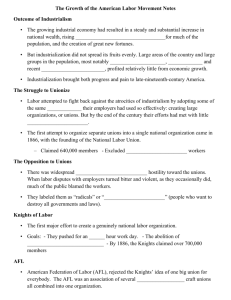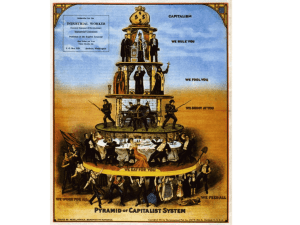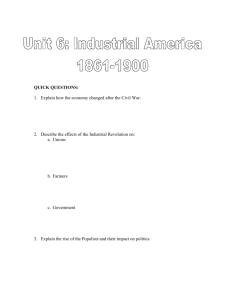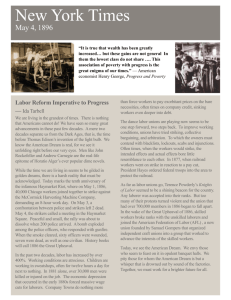powerpoint - Aurora Public Schools
advertisement
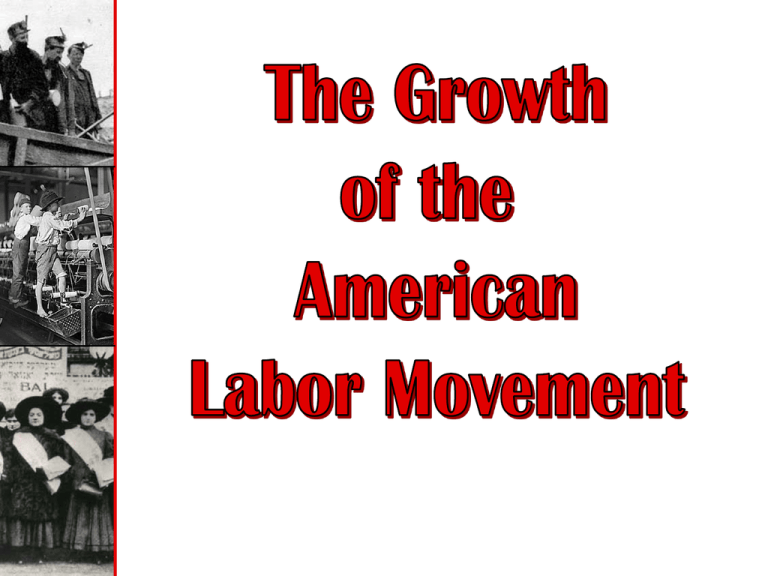
Outcome of Industrialism • The growing industrial economy had resulted in a steady and substantial increase in national wealth, rising living standards for much of the population, and the creation of great new fortunes. • But industrialization did not spread its fruits evenly. Large areas of the country and large groups in the population, most notably minorities, women and recent immigrants, profited relatively little from economic growth. • Industrialization brought both progress and pain to late-nineteenth-century America. “Galley Labor” The Struggle to Unionize • Labor attempted to fight back against the atrocities of industrialism by adopting some of the same tactics their employers had used so effectively: creating large organizations, or unions. But by the end of the century their efforts had met with little success. • The first attempt to organize separate unions into a single national organization came in 1866, with the founding of the National Labor Union. – Claimed 640,000 members – Excluded women workers Labor Union Membership The Opposition to Unions • There was widespread middle-class hostility toward the unions. When labor disputes with employers turned bitter and violent, as they occasionally did, much of the public blamed the workers. • They labeled them as “radicals” or “anarchists” (people who want to destroy all governments and laws). Knights of Labor • The first major effort to create a genuinely national labor organization. • Goals: – They pushed for an 8 hour work day. – The abolition of child labor – By 1886, the Knights claimed over 700,000 members Knights of Labor Terence V. Powderly An injury to one is the concern of all! Knights of Labor Knights of Labor trade card AFL • American Federation of Labor (AFL), rejected the Knights’ idea of one big union for everybody. The AFL was an association of several independent craft unions all combined into one organization. • Goal was to secure for the workers a greater share of capitalism’s rewards. • Supported the immediate objectives of most workers: better wages, hours and working conditions. • While union members hoped to attain its goals through collective bargaining (meaning negotiating), it was ready to use strikes if necessary. Haymarket Square • Industry and government responded forcefully to union activity, which they saw as a threat to the capitalist system. • In May, 1886 3,000 people gathered at Chicago’s Haymarket Square to protest police brutality- a striker had been killed and several had been wounded at the McCromick Harvester Plant the day before. • As police arrived the crowd was dispersing. Then, someone tossed a bomb into the police line. No one knows who threw the bomb, but the three speakers from the demonstration and five radicals were charged. • After Haymarket, the public began to turn against the labor movement. Haymarket Martyrs Haymarket Riot (1886) McCormick Harvesting Machine Co. Other Strikes • To most middle-class Americans, the Haymarket bombing was an alarming symbol of social chaos. • Other violent strikes such as the Homestead strike, which required 8,000 National Guard troops, and the Pullman strike (2,000 troops), turned many Americans against unions. Labor Unrest: 1870-1900 The Great Railroad Strike of 1877 The Great Railroad Strike of 1877 Homestead Steel Strike (1892) Homestead Steel Works The Amalgamated Association of Iron & Steel Workers The Pullman Strike of 1894 Management and Government Pressure Unions • The more powerful the unions became, the more employers began to fear them. Management refused to recognize unions as representatives of the workers. Many employers forbade union meetings, fired union members, and forced new employees to sign “yellow-dog contracts,” swearing that they would not join a union. The Tournament of Today: A Set-to Between Labor and Monopoly Management and Government Pressure Unions • Industrial leaders even turned the Sherman Anti-Trust Act against labor. Industrial leaders would simply say their workers were organizing a strike and the state or federal government would issue an injunction (court order) against labor. Teddy Roosevelt: The Square Deal • Roosevelt became president in 1900. Citing federal responsibility for national welfare, Roosevelt though the government should assume control whenever states proved incapable of solving problems. He explained “It is the duty of the president to act upon the theory that he is the steward of the people, and …to assume that he has the legal right to do whatever the needs of the people demand, unless the Constitution of the laws explicitly forbid him to do it.” Teddy Roosevelt: The Square Deal • Roosevelt believed he should influence the news media and shape legislation for the benefit of the people. He started the “Square Deal” a term used to describe reforms he made to business to help improve life for workers and consumers. Trust Busting • Teddy did not believe that all trusts were harmful, but he sought to curb the actions of those that hurt the public interest. The president filed suits against trusts in the Supreme Court. If the court found the trust was harmful to the consumer, they dissolved it. The Roosevelt administration filed 44 antitrust suits, winning a number of them, but unable to slow the merger movement of big business. Teddy Intervenes for Public Welfare • In 1902 140,000 coal workers went on strike to demand a raise, a 9 hour work day and the right to unionize. Five months into the strike, coal reserves ran low. Roosevelt intervened, calling both sides to the White House and settling the dispute. • Roosevelt’s actions demonstrated a new attitude of the government towards strikes. When a strike threatened public welfare, the federal government was expected to intervene. Teddy Intervenes for Public Welfare • Overall, Roosevelt’s real goal was federal regulation. He established several government organizations to regulate business from establishing high rates, bribery, or other unfair business practices. For example, he had the Elkins Act passed, which made it illegal for railroads to change rates without notifying the public. • Under Roosevelt, and the next presidents Taft and Wilson a series of Progressive Laws were passed that broke up trusts, protected the consumer, and improved working conditions and wages. • The Progressive reading and laws assignments will give further details about these changes.
